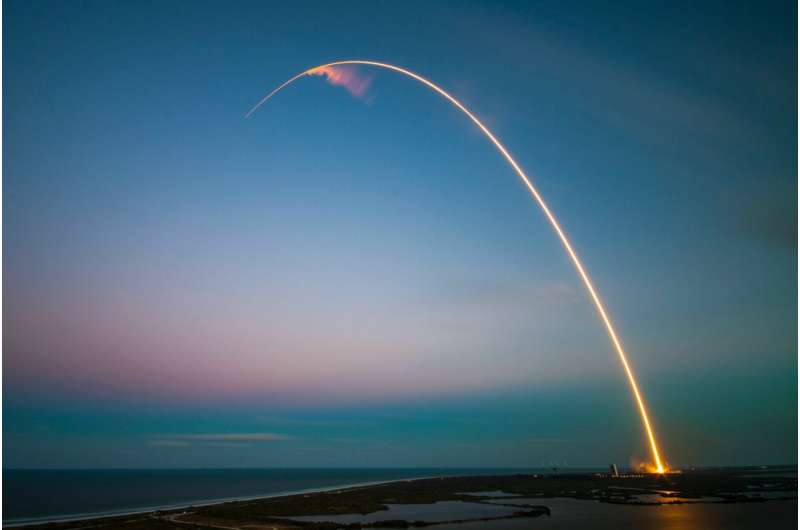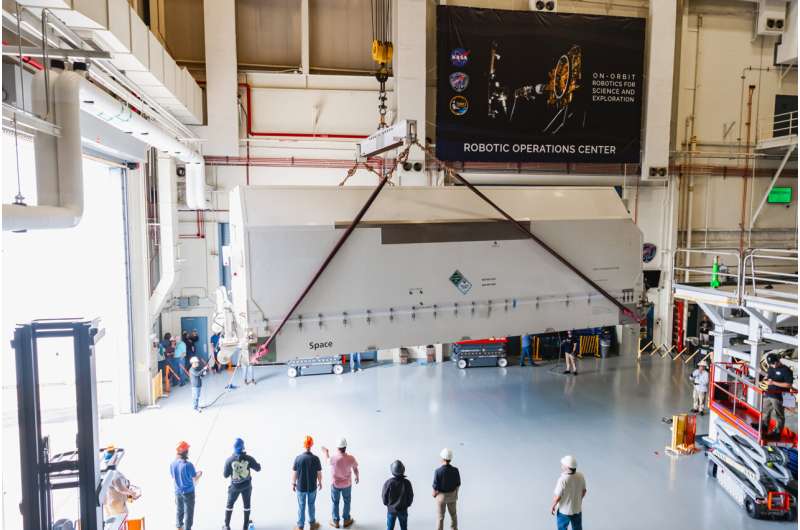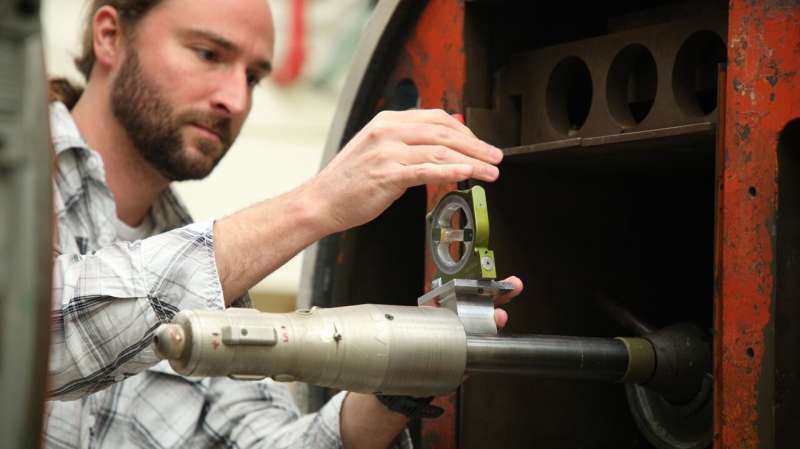
Copernical Team
Historic NASA wind tunnel testing Mars Ascent Vehicle
 The MAV (Mars Ascent Vehicle) team recently completed wind tunnel testing at NASA's Marshall Space Flight Center in a facility that has been a critical part of NASA missions going all the way back to the Apollo program.
The same facility that provided valuable testing for NASA missions to low-Earth orbit and the Moon is now helping the agency prepare to launch the first rocket from Mars. T
The MAV (Mars Ascent Vehicle) team recently completed wind tunnel testing at NASA's Marshall Space Flight Center in a facility that has been a critical part of NASA missions going all the way back to the Apollo program.
The same facility that provided valuable testing for NASA missions to low-Earth orbit and the Moon is now helping the agency prepare to launch the first rocket from Mars. T Did life exist on Mars? Other planets? With AI's help, we may know soon
 Scientists have discovered a simple and reliable test for signs of past or present life on other planets - "the holy grail of astrobiology."
In the journal Proceedings of the National Academy of Sciences, a seven-member team, funded by the John Templeton Foundation and led by Jim Cleaves and Robert Hazen of the Carnegie Institution for Science, reports that, with 90% accuracy, their artifi
Scientists have discovered a simple and reliable test for signs of past or present life on other planets - "the holy grail of astrobiology."
In the journal Proceedings of the National Academy of Sciences, a seven-member team, funded by the John Templeton Foundation and led by Jim Cleaves and Robert Hazen of the Carnegie Institution for Science, reports that, with 90% accuracy, their artifi Zenno and D-to develop superconducting electromagnets
 New Zealand headquartered space-flight systems company Zenno Astronautics (Zenno), a developer of world-first superconducting electromagnets for space applications, and D-Orbit, a company leader in the space logistics industry, have formed a special commercial partnership to collaborate on the development of new space products and services.
The initial project will see Zenno and D-Orbit co
New Zealand headquartered space-flight systems company Zenno Astronautics (Zenno), a developer of world-first superconducting electromagnets for space applications, and D-Orbit, a company leader in the space logistics industry, have formed a special commercial partnership to collaborate on the development of new space products and services.
The initial project will see Zenno and D-Orbit co Curiosity the Cautious Rover: Sols 3957-3959
 Earth planning day: Friday, September 22, 2023: When I opened the workspace imagery this morning, I was happy to see some nice big rock outcrops in reach of the rover and started to pick some nice targets for contact science with APXS, before realizing that one of the rear wheels is perched on a rock. Sure enough, the drive had cut short when the rover detected it had driven over an unexpectedly
Earth planning day: Friday, September 22, 2023: When I opened the workspace imagery this morning, I was happy to see some nice big rock outcrops in reach of the rover and started to pick some nice targets for contact science with APXS, before realizing that one of the rear wheels is perched on a rock. Sure enough, the drive had cut short when the rover detected it had driven over an unexpectedly How OSIRIS-REx is helping scientists study the sonic signature of meteoroids
 In the high desert of Nevada, Elizabeth Silber watched NASA's Sample Return Capsule from OSIRIS-REx descend into Earth's atmosphere on Sunday, but unlike most scientists, she wasn't there for the asteroid rocks.
Silber, a physicist at Sandia National Laboratories, is working with researchers from Sandia and Los Alamos national laboratories, the Defense Threat Reduction Agency, TDA Research
In the high desert of Nevada, Elizabeth Silber watched NASA's Sample Return Capsule from OSIRIS-REx descend into Earth's atmosphere on Sunday, but unlike most scientists, she wasn't there for the asteroid rocks.
Silber, a physicist at Sandia National Laboratories, is working with researchers from Sandia and Los Alamos national laboratories, the Defense Threat Reduction Agency, TDA Research Three Questions: The first asteroid sample returned to Earth
 On Sunday morning, a capsule the size of a mini-fridge dropped from the skies over western Utah, carrying a first-of-its-kind package: about 250 grams of dirt and dust plucked from the surface of an asteroid. As a candy-striped parachute billowed open to slow its freefall, the capsule plummeted down to the sand, slightly ahead of schedule.
The special delivery came courtesy of OSIRIS-REx
On Sunday morning, a capsule the size of a mini-fridge dropped from the skies over western Utah, carrying a first-of-its-kind package: about 250 grams of dirt and dust plucked from the surface of an asteroid. As a candy-striped parachute billowed open to slow its freefall, the capsule plummeted down to the sand, slightly ahead of schedule.
The special delivery came courtesy of OSIRIS-REx Shh! Quiet cables set to help reveal rare physics events
 Imagine trying to tune a radio to a single station but instead encountering static noise and interfering signals from your own equipment. That is the challenge facing research teams searching for evidence of extremely rare events that could help understand the origin and nature of matter in the universe. It turns out that when you are trying to tune into some of the universe's weakest signals, i
Imagine trying to tune a radio to a single station but instead encountering static noise and interfering signals from your own equipment. That is the challenge facing research teams searching for evidence of extremely rare events that could help understand the origin and nature of matter in the universe. It turns out that when you are trying to tune into some of the universe's weakest signals, i SpaceX sets up 200th reflight with Cape Canaveral launch Saturday night

SpaceX's reusability juggernaut keeps rolling with a planned Space Coast launch Saturday night that would mark the 200th time the company has relied on a previously launched booster to get its payloads to space.
A Falcon 9 rocket flying on the Starlink 6-18 mission carrying 22 of its Starlink satellites is set to lift off from Cape Canaveral Space Force Station's Space Launch Complex 40 at 9:07 p.m. with three more options Saturday night from 9:57 p.m. until 12:05 a.m. Sunday. Another four backup options fall Sunday night between 8:41 p.m. and 11:39 p.m.
The first-stage booster is making a record-tying 17th flight with a planned recovery landing down range on droneship Just Read the Instructions in the Atlantic Ocean.
Space Launch Delta 45's weather squadron predicts 95% chance for good conditions, and in the event of a 24-hour delay, chances would be 90% sliding to 80% chance across the three-hour window.
It marks the 200th reuse of a booster among its Falcon 9 and Falcon Heavy rockets. If it sticks the landing, it will be the 228th successful recovery since the first success in December 2015.
Image: Spacecraft bus for satellite servicing mission arrives at NASA Goddard

On Sept. 20, 2023, the On-orbit Servicing, Assembly, and Manufacturing 1 (OSAM-1) spacecraft bus arrived at NASA's Goddard Space Flight Center in Greenbelt, Maryland, after its journey from a Maxar facility in California. Following this critical milestone, engineers at Goddard can begin to integrate the mission's servicing payload onto the bus and begin to test the integrated spacecraft in simulated space environments.
When integration and testing are complete, OSAM-1 will be ready to demonstrate robotic satellite servicing technologies in space. The OSAM-1 mission is planned to be the first to robotically refuel a spacecraft not designed for on-orbit servicing. The servicer will rendezvous with, grapple, and berth the government-owned Landsat 7 spacecraft, and then use a suite of tools to replenish its hydrazine fuel tank.
In addition to the mission's servicing objectives, OSAM-1 will also include an assembly demonstration provided by commercial partner Maxar, the same company that provided the spacecraft bus. That demonstration will use a robotic arm from the Space Infrastructure Dexterous Robot (SPIDER) payload to assemble a functional Ka-band antenna on orbit from stowed hexagonal pieces.
Historic wind tunnel facility testing NASA's Mars ascent vehicle rocket

The MAV (Mars Ascent Vehicle) team recently completed wind tunnel testing at NASA's Marshall Space Flight Center in a facility that has been a critical part of NASA missions going all the way back to the Apollo program.

